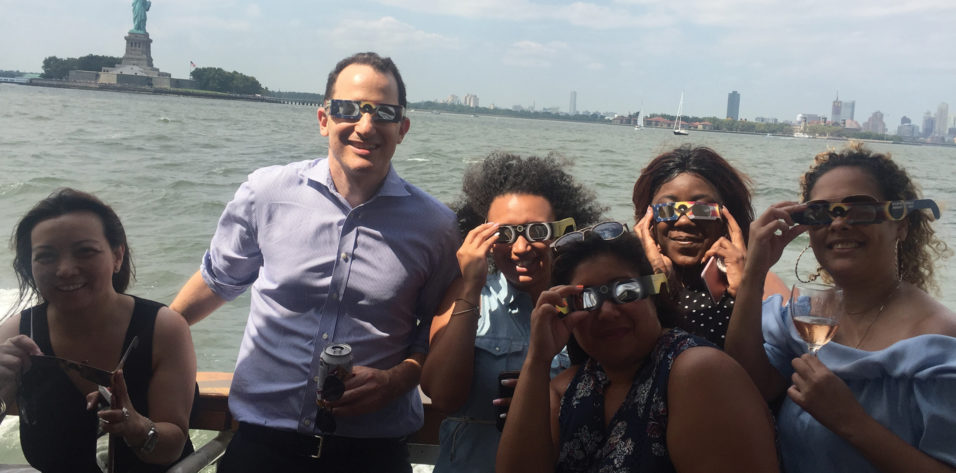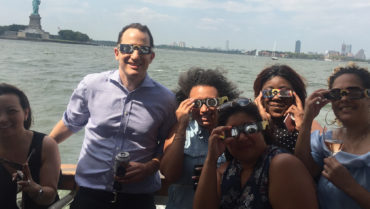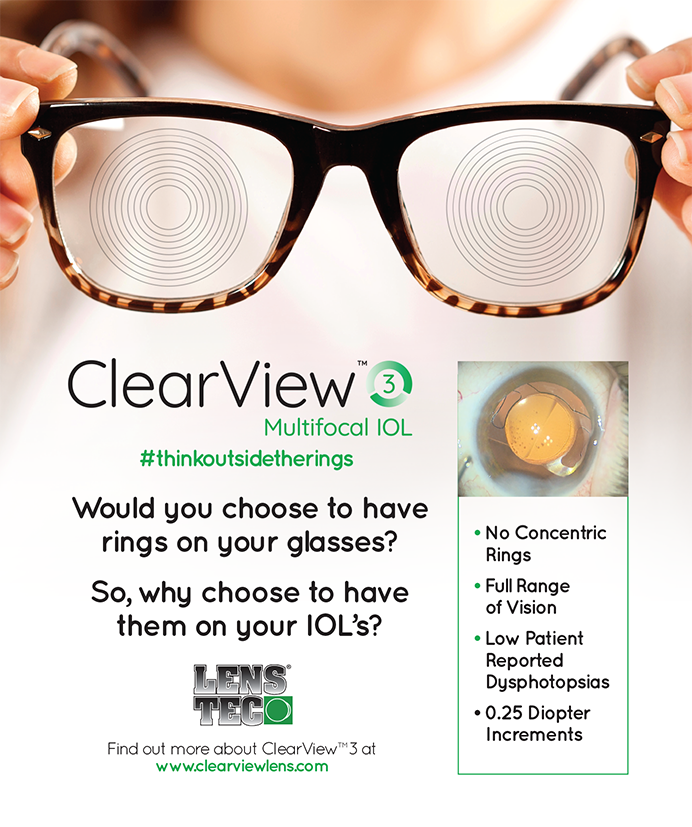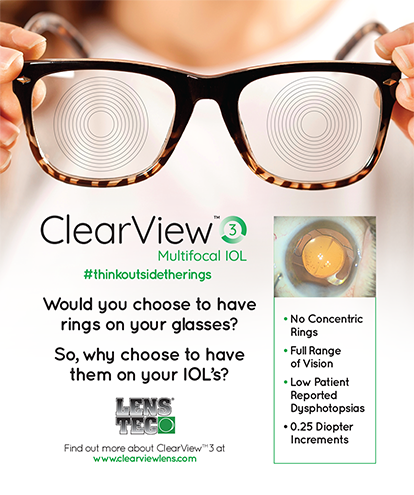The Eye Center of New York (ECNY; eyecenterofny.com), a boutique practice located in the city’s well-heeled hub between Park and Madison Avenues, joins the skills of a distinguished surgeon and the capabilities of innovative technology with impeccably planned form and skillfully calculated function. The components come together in an ethos of world-class eye care with a personalized touch, says ECNY’s founder and medical director, Tal Raviv, MD.
The metropolitan practice is within walking distance of Grand Central Station, making it easily accessible to potential patients up and down the Northeast Corridor, and its prime location also seats it centrally to throngs of commuters and inhabitants of Manhattan, the most densely populated of the Big Apple’s five boroughs (counting commuters).
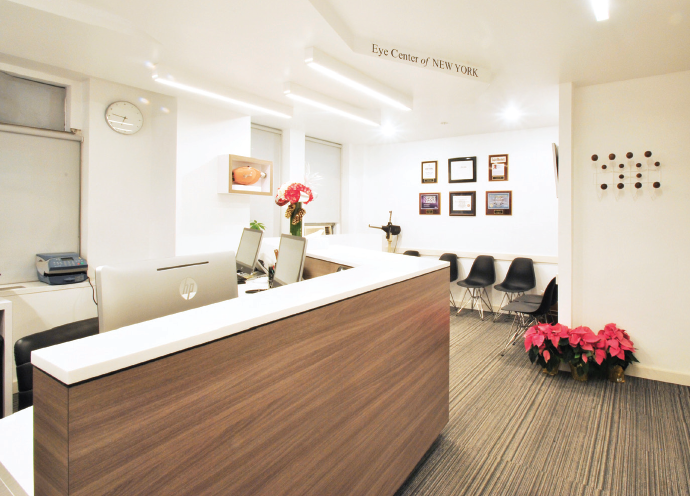
“The practice, which I founded in 2014, builds on the legacy of three consecutive Manhattan solo practicing ophthalmologists before me going back to 1935,” Dr. Raviv told CRST. “In the past 3 years, the practice has grown from a solo medical ophthalmology practice to a busy surgical practice.”
The integrated group practice offers comprehensive ophthalmic and optometric care with a focus on refractive cataract surgery, including microinvasive glaucoma surgery, corneal refractive surgery, and dry eye/ocular surface disease management. It currently operates with two ophthalmologists and two optometrists.
“We have been fortunate to grow referrals, patient visits, and surgical procedures by significant multiples, and we also successfully renovated the physical space,” Dr. Raviv said (see Clinic Redesign Syncs With Elevated Expectations below).
In this article, Dr. Raviv expounds on ECNY’s strengths and strategies, changes in the delivery of health care, and the importance of availability, affability, ability, and affordability with respect to the provision of ophthalmic surgery.
When building a new surgical practice on the foundation of a three-generation loyal patient base, the Eye Center of New York’s founder and medical director, Tal Raviv, MD, had a blank canvas with which to work.
“I was looking to build a high-tech, high-design, and high-touch office,” he explained. “As a refractive cataract surgeon, I wanted a practice that could serve the community and also cater to the most difficult patient groups, those with clinical complexity and those with elevated expectations. In Manhattan, elevated expectations encompass not only technically perfect cataract surgery or hitting a refractive target but also providing the appropriate physical setting, enhanced service, and a memorable experience that patients are accustomed to when purchasing luxury goods and services.”
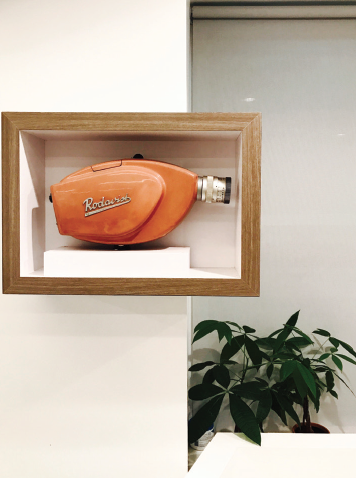
Most physicians’ offices in Manhattan are older with a basic waiting room and reception area. The office that Dr. Raviv took over when opening Eye Center of New York in 2014 had a 1970s look and feel.
“Even though patients didn’t seem to mind, I wanted to transform the space to a modern [environment] that would complement our high-technology vibe and attention to details, while reinforcing the warm and comforting nature of our practice,” said Dr. Raviv.
After interviewing several contractors and architects, he chose Carlo Enzo, founder of Urban Office Architecture in New York, an innovative architect from outside of health care who had a similar vision to Dr. Raviv’s.

“An open modern office plan was developed,” Dr. Raviv said. “We converted the separate waiting room and reception desk area to a more integrated and inviting ‘reception lounge.’ We agreed that no medical office should have a ‘waiting’ room. Also, to pay homage to the practice’s history, we repurposed many of the vintage instruments that the prior ophthalmologist had used and collected from his predecessors as design elements throughout the office. His extensive historical book collection was also culled and displayed in the exam rooms.”
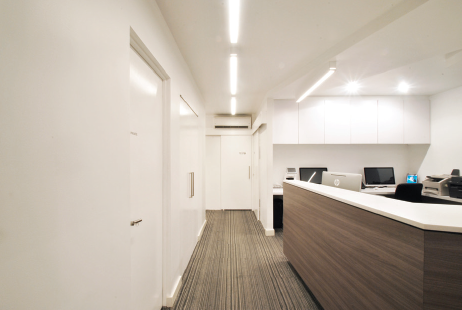
Mr. Enzo described the thought process behind his design as a plan to create a “visually expanded” space, where the eye could follow lines around and somehow perceive a setting that was both larger and more dynamic than the actual confines of the room. “The idea was that, because it was an ophthalmologist’s office, the visual aspect of the patient’s static time (the ‘waiting’) should be made dynamic and inspirational,” he explained. With that in mind, a design was executed that culminated in “a dance between lower and upper vision, earth and sky, so to speak, with pristine but comfortable tones of whites, wood, and light,” he said. “Somehow, one has the ability to create their own visual experience, perhaps a preface to their upcoming medical journey.”
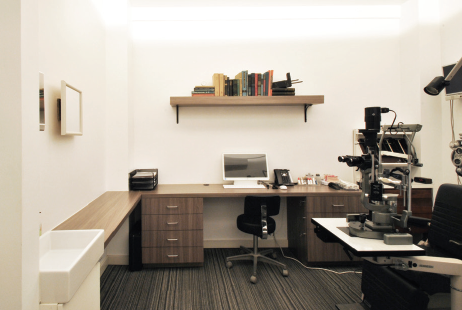
In keeping with the design aesthetic, the placement of equipment, electronics, and other necessary elements had to be carefully considered.
“The space required incredible demands for placement of equipment and procedure rooms, doctor’s office, booking space, reception area, and secretarial operational space as well as substantial storage space,” Mr. Enzo commented. “The design optimizes every inch of the space and allows the staff to use each corner while hiding and organizing the materials needed to run the day-to-day operations. Frameless, flat, and flushed elements such as doors, cabinets, millwork, etc., allow the space to flow as one, while all nooks and crannies are utilized. Sliding doors and bold but minimal graphics allow the space to feel continuous yet sequenced.”
Other design elements that elevate the environment include large, touch-screen liquid crystal displays in every exam lane to walk patients through images of their maculae, meibomian glands, etc. The reception lounge is optimized for patients’ comfort and education, with a specially customized video about the practice and its services, videos of the providers’ media appearances, and footage from medical missions.
Take a virtual tour of the Eye Center of New York.
“I’m surprised by how often patients comment on the iStent [Trabecular Micro-Bypass Stent (Glaukos)] or refractive cataract surgery after watching or hearing these videos play in the background,” Dr. Raviv remarked.
CRST: What is the ECNY’s raison d’être and focus?
Dr. Raviv: In an era of practice consolidation and large impersonal medical systems, our independent practice seeks to provide the attention, human touch, and lasting positive patient experience that any of us would seek for ourselves and our families. A major foundation of the practice rests on delivering consistent outstanding patient outcomes with cataract and refractive surgery. We specialize in high-risk cataract surgery and refractive cataract surgery. Frequently, the two are combined, such as when operating on a dense, small-pupil, postradiation cataract of a patient [who] is post-LASIK and also desires freedom from spectacles. Many of our referrals are from area optometrists, ophthalmologists, and other physicians as well as patient word-of-mouth and, increasingly, self-referral after patient research.
CRST: What is an example of a successful practice management strategy employed by ECNY?
Dr. Raviv: At ECNY, we follow the concepts of the Health 3.0 movement (zdoggmd.com/health-3-point-0), which means we strive to provide the highly personalized care of the past, driven by evidence-based guidelines, utilizing the most modern technologies, by the most skilled surgeons and practitioners and with the singular purpose of achieving outstanding patient outcomes—not checkbox outcomes.
CRST: Is there something specific from your training that you have applied to your practice paradigm?
Dr. Raviv: Twenty years ago, during residency, I was told that the three A’s of a successful surgical practice were availability, affability, and ability. My senior resident walked me through our existing voluntary attendings and convincingly demonstrated that the successful surgeons had at least two of the three characteristics. In the past 2 decades, health maintenance and preferred provider organizations have created a fourth A, affordability or access. If a doctor is not in a patient’s narrow network, the other three A’s may not be as relevant. I’ve often thought about the truths behind the four A’s, and upon starting my own practice, I decided to try to maximize each of them. (See Leading Eye Surgery Practice Aims for Straight A’s below.)
Leading Eye Surgery Practice Aims for Straight A’s
The Eye Center of New York’s (ECNY’s) medical director and founder, Tal Raviv, MD, learned early in his training that accessibility, affability, and ability are key to forging and maintaining a successful practice. Experience, perspective, and the evolving nature of health care delivery prompted him to ensure that his practice is affordable as well. Dr. Raviv explains the importance of the four A’s.
Affordability
After taking over the practice in 2014, I decided to continue participating in all insurance plans, with the addition of Medicaid plans (which in New York are managed by the commercial payors) to ensure affordability and access. When referring doctors send a patient to ECNY, they don’t have to worry about checking their insurance. We therefore treat patients from all socioeconomic strata from the five boroughs of New York City, the tristate area, and beyond.
Accessibility
Most established medical practices have an appointment waiting time of a few weeks to months. We have tried to counter this by leaving a preset number of slots available for same-day walk-ins and add-ons. Furthermore, by having an optometrist and an ophthalmologist working on the same day, add-on patients can usually be seen right away. My staff knows that an incoming new patient’s phone call is a critical lead that represents our first live interaction with the patient. Also, if someone happens to walk in requesting a future appointment, my staff is empowered to offer an appointment on the spot, if the patient is willing to be squeezed in.
In 2017, technology is critical to maintaining accessibility. Patients are able to easily request mobile appointments via our responsive website, and our practice management system, CareCloud (CareCloud; www.carecloud.com), helps automatically confirm appointments by sending text messages and emails and recording patients’ responses back to the practice management system. We also rely on Yosi software (Yosi) to enable patients to skip the clipboard and efficiently check in on their mobile device before the visit. We’ve found that reducing traditional appointment-making friction dramatically increases our patients’ satisfaction and retention.
Affability
This trait describes the collective culture, attitude, and work ethic of the doctors and staff. I’ve encouraged my staff to utilize “outside the clinic” thinking when interacting with patients. Because ECNY is a single-location boutique practice, we have the benefit of quickly developing close relationships with our patients. We frequently have a huddle at the beginning of the day to discuss upcoming patients and a concluding one to evaluate how we did and identify any patient-related issues that arose and need to be addressed.
Of course, a big part of affability is having happy doctors and happy staff, and that is something we cultivate. One of our team-building activities is organizing group events. For example, after providing our patients with weeks of eclipse safety outreach efforts and free eclipse viewing glasses, the staff and doctors took half a day off on August 21 to view the Great American Eclipse on a special cruise around Manhattan.
Ability
In a refractive practice, this A is arguably the most important. Refractive results, whether with corneal or lens-based refractive surgery, are immediately evident and quantifiable to patients. For this reason, the mantra of “achieving outstanding patient outcomes” drives all our decisions.
The surgeon should be a student of the craft. Refractive cataract surgery is a rapidly evolving field that requires continued capital investment, constantly updated procedures and protocols, rapid adaptability to new IOL releases, and continuous peer-to-peer exchange of ideas and methods.
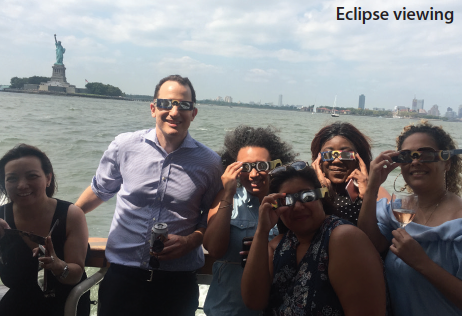
In order to achieve the best results, I decided that I needed to invest in the best corneal topographers, the latest-generation optical biometers, [and] the most accurate new-generation formulas (Barrett Universal II and Hill RBF), and [to] utilize advanced surgical tools such as the femtosecond laser and intraoperative aberrometry. In my opinion, to offer the highest level of refractive cataract surgery, surgeons must be comfortable with handling all postoperative scenarios, including performing an IOL exchange, toric IOL rotation, and corneal refractive surgery, or at least they must partner with a surgeon who can provide those services.
Attending regional and national meetings, being involved in local ophthalmic societies, and having a network of trusted peers to constantly exchange information with are also critical to honing our clinical judgement and acumen.
CRST: Is there anything unique about the geographical area in which ECNY is located that affects the practice?
Dr. Raviv: We are located in densely populated midtown Manhattan, with other ophthalmologists in our building and dozens more within a few blocks. However, we are also surrounded by hundreds of thousands of employees/commuters who frequently obtain their health care in Manhattan. Our focus has always been to provide efficient, no-hassle, no-wait services. We use technology such as Yosi (Yosi; yosicare.com and bit.ly/2yEW7Hq) to allow patients to skip the paper-filled clipboard and have fast-track technician workflows in place. For example, if someone is coming to get [his or her] Department of Motor Vehicles vision check and renewal, my staff will expedite the patient workup to enable an efficient, focused exam that enables the patient to get back to work, license electronically renewed, within 30 minutes. We have similar workflows for acute conjunctivitis and other conditions.
CRST: Is customer service or the patient’s experience really that important?
Dr. Raviv: I believe that focusing on and improving the patient’s experience in your practice is the single most effective intervention practices can make with the most rapid return. Imagine if you were the patient walking into your office. What could be done better? Could the scheduling times or personnel staffing be improved to minimize waiting? Are there cosmetic changes that could enhance the patient’s experience? Are month-old creased magazines sitting on a worn coffee table? Do you want to offer refreshments? Do you offer kiosk or mobile check-in technology? Is there a wall of old pamphlets, or do you have interactive digital content such as display screens with customized practice information? Does your office look and feel like a place where people would invest a few thousand dollars for the luxury of transforming their vision to spectacle freedom?
CRST: Do you have a tip you can share regarding implementing effective methods of operation?
Dr. Raviv: If you are offering premium refractive services with costs comparable to [those of] business-class airline seats, I recommend that your practice administrator visit an American Express Centurion Lounge at a local airport (bit.ly/2yqxsoQ) to get some insight into what the travel and hospitality industry provides to enhance the customer’s experiences.
CRST: What are some health care delivery changes that have affected ophthalmology?
Dr. Raviv: Medicine, for centuries, had been a cottage industry. The past few decades have seen the rise of large health systems, population-health-driven treatment algorithms, and a resulting impersonalization of health care. Consolidated, publicly traded payors manage payments with purposefully labyrinthine rules, and well-meaning, checkbox-driven, performance measures are burdensome without really measuring outcome or value. We are fortunate in private practice ophthalmology to be one of the few specialties—along with dermatology—that can thrive alongside the “Big Med” medical industrial complex. Furthermore, we are able to simultaneously practice in the insurance-reimbursed and private-pay environment, allowing progressive practices to maintain their autonomy.
Dr. Raviv has an equity interest in Yosi software.

